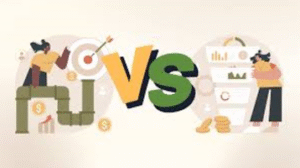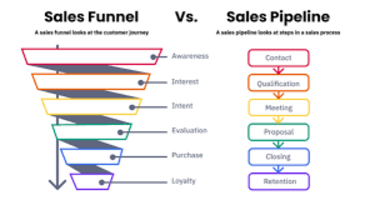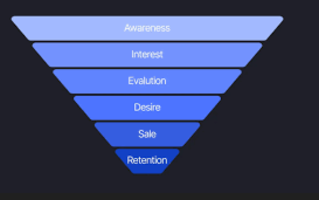Have you ever wondered why some businesses seem to close deals effortlessly while others struggle despite having plenty of leads? The answer often lies in how well they understand and manage their sales process. If you’re in digital marketing or sales, you’ve probably heard the terms sales funnel and sales pipeline thrown around interchangeably.
But here’s the thing – they’re not the same and mixing them up could be costing you conversions. Think of it this way: imagine you’re planning a road trip. The sales funnel is like looking at your journey from the customer’s perspective – all the emotions, decisions, and thoughts they experience from discovering your brand to making a purchase.
The sales pipeline, on the other hand, is your GPS – the concrete steps your sales team takes to guide that customer to their destination. Understanding the difference between a sales funnel vs sales pipeline isn’t just marketing jargon. It’s the foundation for building a revenue-generating machine that consistently delivers results.
In this comprehensive guide, we’ll break down everything you need to know about sales funnels and sales pipelines. You’ll discover how they work, why both matters, and most importantly, how to leverage them together to skyrocket your business growth.

What is a Sales Funnel?
A sales funnel represents the complete journey your potential customers take from first hearing about your product to becoming paying customers. Picture an actual funnel – wide at the top and narrow at the bottom. That’s exactly how the customer journey works.
At the top of your sales funnel, you have a large number of people who become aware of your business. As they move through different stages, some lose interest, some aren’t ready to buy, and others find alternative solutions. By the time prospects reach the bottom, only a fraction converts into actual customers.
The sales funnel focuses on the buyer’s perspective. It tracks how prospects think, feel, and behave as they progress toward a purchase decision. This customer-centric view helps marketers understand what content, messaging, and touchpoints are needed at each stage to nurture leads effectively.
Key characteristics of a sales funnel:
- Represents the customer’s journey and experience
- Shows the gradual narrowing of prospects as they move closer to purchase
- Focuses on marketing activities and customer behavior
- Measures conversion rates between different stages
- Helps identify where prospects drop off in the buying process
Most sales funnels track metrics like website traffic, engagement rates, lead quality, and conversion percentages. These numbers tell you how well your marketing efforts are moving people through the funnel and where improvements are needed.
The beauty of understanding your sales funnel is that it reveals exactly where potential revenue is leaking out. Maybe your social media is driving tons of traffic, but your website isn’t converting visitors into leads. Or perhaps you’re generating quality leads, but they’re not moving to the consideration stage. The sales funnel makes these gaps visible.
What are the 5 Stages of the Sales Funnel?
Every successful sales funnel consists of distinct stages that align with how customers make buying decisions. While some businesses use different names or add extra stages, the classic model includes five essential phases.
Awareness Stage
This is where potential customers first discover your brand. They might stumble upon your social media post, see your advertisement, read a blog article, or hear about you from a friend. At this stage, people are just learning that your business exists. They’re not ready to buy yet – they’re simply becoming aware of who you are and what you offer.
Your goal during the awareness stage is to cast a wide net and capture attention. Content like social media posts, blog articles, videos, podcasts, and display ads work exceptionally well here. You want to provide value and establish your brand as credible and interesting.
Interest Stage
Once people know about you, some will want to learn more. They enter the interest stage when they start actively engaging with your content and exploring your offerings. These prospects might subscribe to your email list, follow your social media accounts, download a free resource, or spend time browsing your website.
During this phase, prospects are educating themselves about their problem and potential solutions. They’re not necessarily thinking about your specific product yet – they’re gathering information. Your job is to position yourself as a helpful expert who understands their challenges.
Consideration Stage
Now things get serious. Prospects in the consideration stage have identified their problem and are actively evaluating different solutions. They’re comparing your product or service against competitors, reading reviews, watching demos, and weighing the pros and cons.
This is where detailed content becomes crucial. Case studies, comparison guides, product demonstrations, webinars, and free trials help prospects see why your solution is the right choice. You’re no longer just building awareness – you’re making a compelling case for why they should choose you.
Intent Stage
The intent stage is that exciting moment when a prospect signals they’re ready to buy. They might add items to their shopping cart, request a quote, schedule a consultation, or start a free trial with the clear intention of purchasing.
These are hot leads who need that final push to convert. Your focus should be on removing any remaining obstacles and making the buying process as smooth as possible. Address common objections, offer limited-time incentives, and provide excellent customer support to seal the deal.
Purchase Stage
Finally, the prospect becomes a customer. They complete the transaction and pay for your product or service. But here’s what many businesses get wrong – the sales funnel doesn’t actually end here.
The purchase stage is really just the beginning of a new relationship. Smart businesses immediately focus on onboarding, customer satisfaction, and retention. Happy customers become repeat buyers and refer others, feeding new prospects back into the top of your funnel.

What is Another Name for a Sales Pipeline?
The sales pipeline goes by several different names depending on your industry and company culture. You might hear it called a revenue pipeline, deal pipeline, or opportunity pipeline. Some organizations simply refer to it as their pipeline without adding any qualifier.
In certain B2B contexts, especially in enterprise sales, people use the term sales process interchangeably with sales pipeline. While there are subtle differences between these concepts, they generally describe the same thing – the systematic stages that deals move through from initial contact to closed sale.
Customer relationship management systems often label it as the deal pipeline or opportunity pipeline. These terms emphasize that you’re tracking specific deals or opportunities rather than general prospects.
Regardless of what you call it; the sales pipeline serves the same fundamental purpose: it provides a visual representation of where each potential deal stands in your sales process. It’s the operational framework your sales team uses to manage their daily activities and forecast revenue.
Understanding the Sales Pipeline in Depth
While the sales funnel tracks the buyer’s journey, the sales pipeline focuses on the seller’s activities. It’s an internal tool that shows all the active deals your sales team is working on and what stage each deal has reached.
Think of your sales pipeline as a dashboard that displays every opportunity currently in progress. Each potential deal is positioned at a specific stage based on the actions your sales team has completed. This visibility allows managers to forecast revenue, identify bottlenecks, and coach team members effectively.
Core elements of a sales pipeline:
- Represents specific deals and opportunities being pursued
- Tracks the seller’s actions and sales activities
- Shows the monetary value of each deal in progress
- Provides revenue forecasting capabilities
- Helps prioritize which deals need immediate attention
Unlike the sales funnel, which deals with percentages and conversion rates, the sales pipeline deals with actual dollar amounts. Each opportunity in your pipeline has an estimated value, and by looking at the total value of all deals at each stage, you can project how much revenue you’ll likely close this month or quarter.
The sales pipeline is where theory meets reality. While your funnel might show that thirty percent of qualified leads eventually convert, your pipeline shows you exactly which specific deals are likely to close this week, and which ones need more nurturing.
What is the Difference Between Sales Pipeline and Sales Cycle?
Here’s another common source of confusion – the sales pipeline and sales cycle are related but distinct concepts that work together in your sales process.
The sales pipeline is a visual representation of where your active deals currently stand. It’s like a snapshot showing you which stage each opportunity has reached right now. Your pipeline might include dozens or even hundreds of individual deals, each positioned at different stages based on your sales team’s progress.
The sales cycle, however, refers to the length of time it takes for a deal to move through your entire pipeline from start to finish. It measures the average duration from first contact with a prospect until they become a paying customer.
Sales Pipeline characteristics:
- A tool for tracking and managing active opportunities
- Shows the current status of all deals in progress
- Used for forecasting and sales team management
- Changes constantly as deals move or close
- Focuses on deal stages and value
Sales Cycle characteristics:
- The time period from first contact to closed deal
- Measures how long conversions typically take
- Varies by industry, product, and customer type
- Used for planning and resource allocation
- Focuses on duration and efficiency
Understanding your sales cycle helps you manage your sales pipeline more effectively. For example, if your average sales cycle is ninety days, you know that deals entering your pipeline today probably won’t generate revenue for another three months. This insight is crucial for accurate forecasting and cash flow planning.
A shorter sales cycle means deals move through your pipeline quickly, generating revenue faster. A longer sales cycle requires more patience and more touchpoints to keep prospects engaged. Neither is inherently better – what matters is understanding your specific sales cycle so you can optimize your pipeline accordingly.
Sales Funnel vs Sales Pipeline: The Critical Differences
Now that we’ve explored each concept individually, let’s directly compare the sales funnel vs sales pipeline to highlight their key differences.
Perspective
The sales funnel adopts the customer’s viewpoint. It maps out their experience, emotions, and decision-making process from discovery to purchase. The sales pipeline takes the seller’s perspective, tracking the specific actions and stages your sales team manages.
Purpose
Sales funnels help marketers understand buyer behavior and optimize the customer journey. They reveal where prospects drop off, and which marketing efforts are most effective. Sales pipelines help sales teams manage their workload, prioritize opportunities, and forecast revenue accurately.
Measurement Focus
Funnels measure conversion rates, percentages, and the overall volume of prospects at each stage. Pipelines measure specific deal values, win rates, and the monetary amount tied to each opportunity.
Ownership
Marketing teams typically own the sales funnel, focusing on generating awareness, interest, and qualified leads. Sales teams own the pipeline, managing individual deals and moving opportunities toward closed-won status.
Scope
The sales funnel is broader and includes everyone who interacts with your brand, even those who never become serious prospects. The sales pipeline is narrower and only includes qualified opportunities that have real potential to convert.
Time frame
Funnels often track prospects over weeks or months as they gradually move through awareness, consideration, and decision stages. Pipelines track active deals that are closer to closing, often within a more compressed time frame.
Actionability
Sales funnels inform strategic decisions about marketing campaigns, content creation, and audience targeting. Sales pipelines drive tactical decisions about which deals to prioritize, when to follow up, and how to allocate sales resources.
Why Both the Sales Funnel and Sales Pipeline Matter
Here’s the truth that many businesses miss – you don’t choose between a sales funnel and a sales pipeline. You need both working in harmony to drive consistent revenue growth.
The sales funnel and sales pipeline are complementary systems that cover different aspects of your revenue generation process. The funnel ensures you’re attracting the right prospects and nurturing them effectively. The pipeline ensures your sales team is managing opportunities efficiently and closing deals consistently.
When your funnel and pipeline are aligned, magic happens. Marketing generates high-quality leads that sales can convert, and sales provides feedback that helps marketing refine their targeting and messaging. This collaboration creates a smooth handoff from marketing to sales and eliminates the finger-pointing that happens when things go wrong.
Companies that excel at both funnel and pipeline management see remarkable results. They generate consistent leads, convert them at higher rates, close deals faster, and forecast revenue more accurately. They also identify problems quickly because they can see exactly where the breakdown is occurring.
How to Optimize Your Sales Funnel
Improving your sales funnel requires understanding what’s happening at each stage and making strategic adjustments based on data.
Analyze your conversion rates
Start by calculating the conversion rate between each stage of your funnel. What percentage of aware prospects become interested? What percentage of interested leads move to consideration? These numbers reveal your strengths and weaknesses.
Create stage-specific content
Different stages require different content types. Top-of-funnel prospects need educational blog posts and entertaining social media content. Middle-funnel leads want comparison guides and case studies. Bottom-funnel prospects need product demonstrations and testimonials.
Implement lead scoring
Not all leads are created equal. Lead scoring helps you identify which prospects are most likely to convert based on their behavior and characteristics. This allows you to focus resources on your best opportunities.
Reduce friction
Look for obstacles that prevent prospects from moving forward. Is your website slow to load? Are your forms too long? Is your pricing confusing? Remove these barriers to improve conversion rates.
Test and iterate
Continuous improvement is key. Test different headlines, calls-to-action, landing page designs, and email sequences. Small improvements at each stage compound into significant overall gains.
How to Optimize Your Sales Pipeline
A well-managed sales pipeline accelerates deals and increases close rates.
Define clear stage criteria
Every member of your sales team should know exactly what qualifies a deal to move from one stage to the next. Vague definitions lead to inconsistent pipeline management and inaccurate forecasting.
Keep your pipeline clean
Regularly review deals in your pipeline and remove opportunities that have gone cold or are unlikely to close. A cluttered pipeline gives you a false sense of security and makes forecasting unreliable.
Focus on velocity
Track how long deals spend in each stage and identify bottlenecks. If opportunities are getting stuck at a particular point, dig into why and address the underlying issue.
Prioritize high-value opportunities
Not every deal deserves equal attention. Use a combination of deal size, close probability, and strategic importance to prioritize where your team spends their time.
Leverage automation
Use CRM systems and automation tools to handle routine tasks like follow-up reminders, email sequences, and data entry. This frees your sales team to focus on building relationships and closing deals.
Aligning Your Sales Funnel and Pipeline for Maximum Impact
The real competitive advantage comes from integrating your sales funnel and sales pipeline into a cohesive system.
Establish clear handoff points
Define exactly when marketing hands a lead to sales. This typically happens when a prospect becomes a marketing qualified lead based on specific criteria. Clear handoffs prevent leads from falling through the cracks.
Create shared metrics
Marketing and sales should agree on common definitions and shared KPIs. What constitutes a qualified lead? What’s an acceptable conversion rate? Aligned metrics foster collaboration instead of conflict.
Enable feedback loops
Sales should regularly tell marketing which leads are converting well and which aren’t. Marketing should share insights about what content and messages are resonating. This two-way communication improves both the funnel and pipeline.
Use integrated technology
Your marketing automation platform and CRM system should connect seamlessly, allowing information to flow freely between them. This integration provides visibility into the entire customer journey.
Hold regular alignment meetings
Bring marketing and sales together routinely to review performance, share insights, and solve problems collaboratively. These meetings break down silos and build a unified revenue team.
Common Mistakes to Avoid
Even experienced professionals make errors when managing their sales funnel and pipeline.
Confusing the two concepts
Using sales funnel and sales pipeline interchangeably creates confusion. Be precise in your language so everyone understands which system you’re discussing.
Neglecting one in favor of the other
Some companies focus heavily on funnel optimization while ignoring pipeline management, or vice versa. Both require consistent attention for optimal results.
Failing to update regularly
Your sales pipeline should be updated at least weekly, if not daily. Stale data leads to poor decisions and missed opportunities.
Setting unrealistic stage criteria
If your pipeline stages are too easy to advance through, deals will look more progressed than they actually are. If they’re too strict, salespeople will get discouraged. Find the right balance.
Ignoring the data
Both your funnel and pipeline generate valuable insights. Ignoring these signals means missing opportunities to improve performance.
FAQs
What comes first, sales funnel or sales pipeline?
The sales funnel typically comes first from a prospect’s perspective. Potential customers enter the top of your funnel when they first become aware of your brand. As they move through the funnel stages and become qualified leads, they then enter your sales pipeline where your sales team actively works the opportunity.
However, both systems run continuously and simultaneously in a healthy business, with new prospects constantly entering the funnel while deals progress through the pipeline.
Can you have a sales pipeline without a sales funnel?
Technically yes, but it’s not advisable. A sales pipeline without a funnel means you have no systematic process for generating and qualifying leads before they reach your sales team. This results in salespeople spending time on unqualified prospects who aren’t ready to buy. The funnel ensures that only quality leads enter your pipeline, making your sales process much more efficient and effective.
How many stages should a sales pipeline have?
Most effective sales pipelines have between five and seven stages. Too few stages provide insufficient visibility into where deals actually stand, making forecasting difficult. Too many stages create unnecessary complexity and slow down your sales process.
The right number depends on your specific sales cycle and business model. B2B companies with complex solutions typically need more stages than B2C businesses with straightforward products.
What’s a good conversion rate for a sales funnel?
Conversion rates vary dramatically by industry, business model, and traffic source. Generally, converting two to five percent of top-of-funnel visitors into customers is considered reasonable for e-commerce. B2B companies often see lower percentages at the top but higher rates once leads are qualified. Rather than comparing yourself to industry averages, focus on improving your own baseline conversion rates over time.
How do sales funnels and pipelines affect revenue forecasting?
Sales funnels help forecast the volume of leads that will enter your pipeline in future periods based on current marketing performance. Sales pipelines provide more immediate revenue forecasting by showing the total value of deals at each stage and their probability of closing. Together, they give you both short-term visibility into likely revenue this month or quarter and longer-term projections about future quarters based on funnel activity.
Conclusion
Understanding the difference between a sales funnel vs sales pipeline is essential for anyone serious about growing their business. These aren’t just theoretical concepts – they’re practical frameworks that directly impact your ability to attract prospects, close deals, and generate predictable revenue.
The sales funnel maps your customer’s journey from first awareness to final purchase, helping you optimize marketing efforts and improve the buyer experience. The sales pipeline tracks your sales team’s activities and opportunities, enabling better deal management and revenue forecasting. Both are indispensable, and both require ongoing attention and optimization.
The most successful businesses don’t choose between funnel and pipeline management – they excel at both. They create seamless experiences that guide prospects smoothly from initial awareness through to becoming loyal customers. They align their marketing and sales teams around shared goals and metrics. They use data from both systems to continuously improve their processes.
Your sales funnel and pipeline are living systems that should evolve as your business grows and your market changes. Stay curious, stay data-driven, and stay focused on delivering value at every stage of your customer’s journey.



